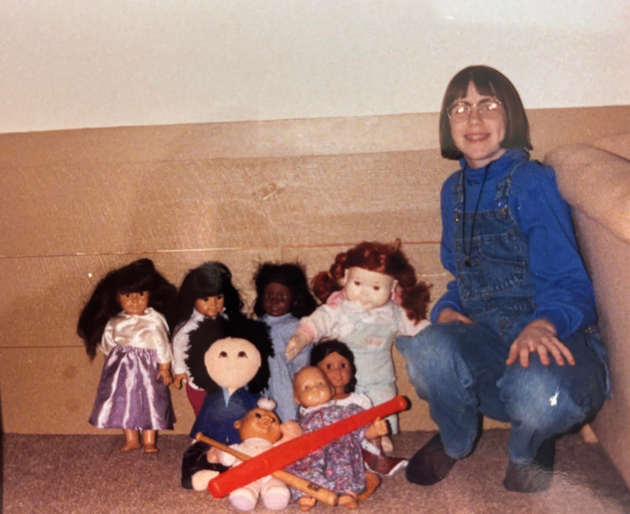A Journey Back to Childhood with American Girl Dolls
I arrived half an hour early to the Boston Public Library, anxiously clutching a canvas tote bag with my childhood Samantha doll inside. The event managers admired my punctuality but told me I couldn’t go into the room yet — so I picked a nearby table and sat, discreetly eyeing the other patrons. For anyone with a large-ish bag beside them, I wondered: Were they going to this book talk? And, if so, had they brought a doll? Was I the only one who had?
I was there to see Mary Mahoney and Allison Horrocks — historians, podcasters and authors of the book “Dolls of Our Lives: Why We Can’t Quit American Girl.” For the uninitiated: Each of the original American Girl dolls portrays a preteen girl from a particular time period in American history, accompanied by six chapter books of illustrated stories. I had grown up with these dolls, which were first introduced in 1986, and the podcast played to millennial nostalgia like mine. The English teacher in me also enjoyed Mahoney and Horrocks’ “hot takes” on each book’s plot, characters, and representations of power and privilege. (Some have aged better than others.) In short, I was a fan, and I had been sure that other fans would bring their dolls to the library.
Finally, 10 minutes before the event, the dolls began to arrive. Rebecca, from 1914, strapped into her official American Girl carrier by a rabbi who told me how thrilled she had been when AG finally made a Jewish historical doll. Kaya, a Nez Perce from 1764 and the first doll with a closed-mouth smile. A smattering of “Just Like You” dolls, the present-day iteration that you can purchase in your own likeness. And, of course, Samantha, the Victorian orphan living with her grandmother and the owner of a truly enviable wardrobe.
As we filed into the auditorium, I couldn’t help noticing that other dolls were more elegantly dressed than mine, and more preciously coiffed. My Samantha’s blue-checkered dress and pinafore had stains here and there, and much of her hair had been pulled out over years of vigorous brushing. She looked a little scrappy by comparison. Then again, she had once regularly played shortstop in “American Girl baseball,” an exercise in compromise between my younger brother and me in which motley teams of dolls and stuffed animals would boink a miniature ball and “run” around the bases. My dolls had never been merely for display; I had really played with them. Until, of course, I was too old.
Mary and Allison came onstage to our applause — best friends, the perfect counterparts, and both self-proclaimed “Mollys.” They admired the Samanthas and Felicitys and “Just Like Yous” in the crowd, and they asked this question: Why, exactly, was it weird or wrong for an adult woman — everyone I saw in the audience presented as female — to play with a doll?
I pondered this. Hadn’t I been ashamed, just an hour before, to be carrying Samantha in a canvas bag on the commuter rail?
Allison pointed out (at the risk of being binary about it all) that pastimes like collectible action figures, sci-fi fandom, and video games have gone mainstream for adults as a part of “nerd culture” — a culture that, while affirming and accepting to many with those interests, continues to be a predominantly male space. Meanwhile, there is no equivalent, socially acceptable culture for adults with an interest in “girl toys.” In fact, if you were 37, as I was, and still played with a doll, you would be deemed less of a “nerd” and more of a weirdo — even creepy.
At the time I attended this book talk, my husband had been spending his evenings playing an online game that involved crashing a lineup of cartoon animals into an internet stranger’s lineup of cartoon animals. Did I ever ask him, “Why the heck are you playing that juvenile, waste-of-time game?” No. I didn’t find that fun, but I knew it was fun for him.
I left that book talk with a sense of purpose that felt visionary. I knew exactly what I needed to do: I needed to buy a doll.
As a child, I owned four American Girl dolls — a luxury my parents had been able to afford due to an extended family member who got us a discount. (Fun fact: The $82 a doll cost in 1993 is the equivalent of about $172 today.)
In my imagination, my four girls were sisters, and I was “Mom.” The girls went to school (a space I’d cleared by shoving aside clothes hanging in my closet) with tiny satchels and tin lunch pails; they confided in me while I braided their hair; they bickered with each other, made up, and then put on nightgowns and climbed under patchwork quilts to sleep.
I had an uncomplicated view of the dolls’ racial mix: Samantha, a white Victorian; Addy, a Black American who ushers in the end of the Civil War; Josefina, who lives on an 1824 rancho in what would later become New Mexico; and an East Asian “Just Like You” who, noticeably, did not look like me.
Although American Girl has expanded its racial representation over the years, it still doesn’t ask, or answer, some of the more complex questions about the racial dynamics and meanings that accompany any given doll. For example, what does it mean for a white child to “own” an Addy doll, as I did? Or to play with replicas of authentic Indigenous dress like Kaya’s?
I didn’t think about any of that when I was 7. In true white ’90s fashion, I’d viewed my little doll family as an aspirational model of racial harmony. Once, I lifted Samantha’s skirt to show a friend how she had bloomers underneath — and that friend laughed. I hadn’t meant to be funny. I’d thought the bloomers were remarkable: See, she has everything.
Sadly, my love of dolls was crushed by the time I reached my teen years. I had held on longer than most and, up to age 12, could still find one or two friends who would secretly, shamefully, play American Girls with me in the basement. Eventually, though, I stopped taking them off the shelf, and they sat in whatever historically accurate outfit I had last dressed them in, collecting dust in their synthetic hair.
Twenty-five years later, though, “Dolls of Our Lives” had unexpectedly rekindled my interest. My first thought was to go online and purchase a new doll from the American Girl website — maybe a “Just Like You” that actually did resemble me. But then I started thinking about other dolls: 2001 “Girl of the Year” Lindsey Bergman, for example, who had been released once I was past acquiring new dolls myself, but whose curls, freckles, and red-beaded hair clip I had gazed at longingly whenever the two neighbor girls I babysat brought her out to play.
Then I discovered eBay. This was an entirely new notion to me: that all the dolls of my childhood — the ones about which my parents had once said, “I think you have enough” — were now available abundantly and affordably, and here I was, an adult with disposable income. Not only that, but the online photographs revealed dolls who needed me. They were, in a word, sad. Wild haircuts, stuck eyelids, naked limbs splayed at odd angles. They appealed to every anthropomorphizing instinct I had once tried so hard to squelch. I was hooked.
“Lindsey, Loose Legs,” one of the eBay listings read. The photo showed a mussy-haired Lindsey, missing one set of eyelashes, doing an impossible split. That’s the one,” I told my husband, who at the time was the one with an eBay account. We clicked “Buy It Now” — and waited.
I had forgotten what this part was like: the anticipation of that tall, narrow box that served as a vessel for an 18-inch companion. Rushing to the door for every postal delivery. Slouching back inside empty-handed when she hadn’t arrived yet. Imagining what it would be like to hold her, to look into her “sleepy eyes” that open and close and to see her looking back. The waiting made me feel like a child again, bursting with eagerness and impatience.
While I waited, I discovered an online community of American Girl doll enthusiasts that I had never known existed. These were people who not only collected dolls but also named, attired and imagined entire personalities and backstories for them. I watched “unboxing” videos where YouTubers shared their first impressions of a new edition doll. I watched “My Collection” videos, where people literally held each of their dolls up to the camera and talked about them. (I found these inexplicably riveting.) But my favorites were the restoration videos, which took seemingly hopeless cases who had tangled hair, scratched vinyl, and permanent marker tattoos and gave these old dolls new life.
When Lindsey Loose-Legs arrived, I lifted her reverently from the box and hugged her. A new doll! Granted, her face was smudged with grime and her legs swung back and forth like a marionette’s — but she was mine. “Whoa,” my husband said, when I let him hold her. “This feels good.” He meant the weight of her, the cloth body, the real-seeming heft. I agreed.
One year later, I am a proud, fully realized American Girl doll fan. In addition to my own collection, now proudly on display, I purchase other people’s American Girl castoffs online, restore them, and sell them again for someone new — child or adult — to enjoy. I’ve learned how to tighten limbs, pop out and replace eyeballs, unstuff and restuff a cloth body, and lovingly wash and restyle frizzed-out doll hair.
Mary and Allison have stopped doing their podcast — they covered every historical doll and book currently in existence — but I like to think that I’m carrying on their mission by keeping dolls in circulation. So far, I haven’t encountered anyone who’s raised an eyebrow at my hobby; maybe I’m an inspiration, or maybe the restoration element adds a legitimacy that would be missing if I acquired dolls simply for myself.
Here’s the truth, though, which I’ll share with you as freely as my husband will share that he still enjoys spending an afternoon on the floor with his Legos: I talk to them. When I open a recycled box and move aside layers of improvised packing material to find a 1990s Samantha looking up at me from behind messy bangs and half-thinned lashes, I’ll say to her, “Samantha, look what they did to you! Don’t worry, I’ll fix you right up.” Oh, thank you! She says back to me. And then, I play.







